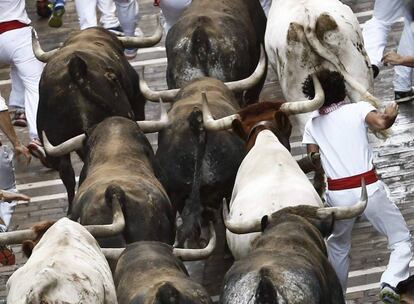The madness of Pamplona’s Sanfermines
Despite a mortality rate of just 0.017%, for 54% of the runners it’s a one-off event fueled by excitement and fear and the desire to feel alive at the end of it

The running of the bulls at the fiesta of San Fermín is madness. The gates are opened at 8am and six bulls weighing at least 600kg each are released with six steers from their corral to charge through fenced streets of the old quarters of Pamplona.
The bulls have been selected from some of the most famous fincas in Spain and their job is to chase a crowd of around 2,000 runners who might press their backs to the wall and let them past, or try to touch them, or simply run for their lives, trying to make sure they have space in the crush and are not pushed down by a fellow runner.
It is not hard to be gored by a bull’s horn or stamped on by a hoof, so reaching the bullring in one piece is synonymous with victory – a Spanish tradition that fascinated Ernest Hemingway, inspiring his novel The Sun Also Rises, and which defies all logical explanation.
Those hoping to play it safe can watch it on TV or from a balcony
The running of the bulls is madness. Sixteen runners have lost their lives and hundreds have sustained injuries at an event that would have no meaning if it did not entail the risk and danger inherent in the tremendous strength of a scared bull longing for the peace of his meadow and trying to rid himself of a bunch of runners who are harassing him for no good reason.
The bull-run is, however, at the heart of the fiesta. Far from being child’s play, the running of the bulls is an aspect of the fiesta that flirts with tragedy, encouraging runners to expose themselves to death in order to feel more alive. Without it, Sanfermines would be nothing more than an orgy of food and drink.
The bull-run is like a primal test, the mystery of which many locals carry deep within them and which others who come from afar hope to experience through the proximity of the bull. It is a tradition that unites thousands of people for eight days that feel like an eternity.
The festivities begin on July 7, the day of Saint Fermín, patron saint of Navarre, when three minutes before 8am, young men holding newspapers pray aloud to a small statue of the saint, placed in a raised niche in the Cuesta de Santo Domingo. “We ask Saint Fermín, our patron Saint, to guide us in the bull-run and give us his blessing,” they chant. Moments later, the bulls are upon them.
Sign up for our newsletter
EL PAÍS English Edition has launched a weekly newsletter. Sign up today to receive a selection of our best stories in your inbox every Saturday morning. For full details about how to subscribe, click here.
The most famous of all Spain’s festivals, the Sanfermines date back to the 14th century, when bulls were herded into the city by cattle merchants, who completed the last stretch in the early hours to avoid inconveniencing local residents.
Until the middle of the 19th century, the running of the bulls ended in Plaza de Castillo, which was used temporarily as a bullring; later, there would be four different routes leading to four different plazas. Finally, in 1992, the current bullring was inaugurated and runners and bulls now take just a few minutes to run the 825 meters, a ritual that turns the streets into a mad dash of fear and excitement every morning for eight days.
The participating bulls have been selected from various fincas; from Fuente Ymbro for the 12th time, Cebada Gago, for the 28th, Escolar, for the second time; Pedraza de Yeltés, for the first; Jandilla for the 16th, Victoriano del Río and Nuñez del Cuvillo for the sixth, and the veteran Miura for the 36th.
The bulls from these various fincas have left countless scars over the years, particularly on the most inexperienced and fearful runners. But this year, there will be more than 100 people on hand to mop up the blood and tend to the wounded. Besides 16 fully equipped ambulances, there will be nine doctors, nine nurses, 21 ambulance crew, 47 rescue workers, nine operators and eight coordinators. In total, there will be nine clinics and another eight backups, which means one for every 53 meters of the bull-run.
Those hoping to play it safe can watch it on TV or from a balcony – for €85, you can rent a third-floor balcony with coffee and cake to sweeten the experience. Or you can wait for the runners and bulls to arrive in the bullring where a musical jamboree is laid on for €6 while you wait.
However you look at it, the running of the bulls is madness. In fact, for 54% of the runners, it is a one-off; perhaps they know that the risk of death is 0.017%. Not much, but it’s there.
English version by Heather Galloway.
Tu suscripción se está usando en otro dispositivo
¿Quieres añadir otro usuario a tu suscripción?
Si continúas leyendo en este dispositivo, no se podrá leer en el otro.
FlechaTu suscripción se está usando en otro dispositivo y solo puedes acceder a EL PAÍS desde un dispositivo a la vez.
Si quieres compartir tu cuenta, cambia tu suscripción a la modalidad Premium, así podrás añadir otro usuario. Cada uno accederá con su propia cuenta de email, lo que os permitirá personalizar vuestra experiencia en EL PAÍS.
¿Tienes una suscripción de empresa? Accede aquí para contratar más cuentas.
En el caso de no saber quién está usando tu cuenta, te recomendamos cambiar tu contraseña aquí.
Si decides continuar compartiendo tu cuenta, este mensaje se mostrará en tu dispositivo y en el de la otra persona que está usando tu cuenta de forma indefinida, afectando a tu experiencia de lectura. Puedes consultar aquí los términos y condiciones de la suscripción digital.
More information
Archived In
Últimas noticias
Reinhard Genzel, Nobel laureate in physics: ‘One-minute videos will never give you the truth’
Pinochet’s victims grapple with José Antonio Kast’s rise in Chile
From digital curfews to blocking apps: How technology experts protect their children online
Why the price of coffee has skyrocketed: from Brazilian plantations to specialty coffee houses
Most viewed
- Pablo Escobar’s hippos: A serious environmental problem, 40 years on
- Why we lost the habit of sleeping in two segments and how that changed our sense of time
- Trump’s obsession with putting his name on everything is unprecedented in the United States
- Charles Dubouloz, mountaineering star, retires at 36 with a farewell tour inspired by Walter Bonatti
- The Florida Keys tourist paradise is besieged by immigration agents: ‘We’ve never seen anything like this’











































